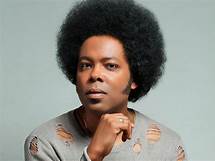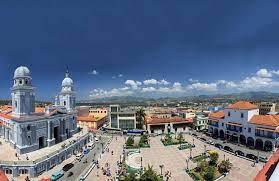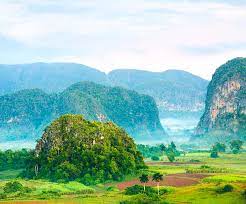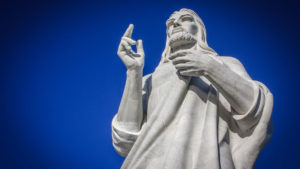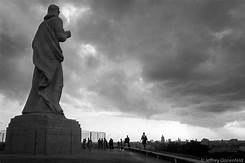ALEX CUBA, MÚSICO, COMPOSITOR OF AFRO-JAZZ AND POP. GANADOR DE GRAMMY 2022. VIDEOS
Alexis Puentes, más conocido por su nombre artístico Alex Cuba, es un cantautor cubano-canadiense que canta en español e inglés nacido en Artemisa el 29 de marzo de 1974.
Ha ganado dos Premios Juno por Álbum de Música Mundial del Año: en 2006 por Humo de Tabaco, y en 2008 por su segundo álbum, Agua del Pozo. En 2010 ganó el Grammy Latino a Mejor Artista Nuevo. Su álbum de 2015, Healer, le valió un premio Grammy Latino al Mejor Álbum de Cantautor y una nominación al Premio Grammy al Mejor Álbum Pop Latino. Su álbum Mendó del 2021 ganó el Grammy 2022 al Mejor Álbum Pop Latino.
Cuba es hijo del guitarrista y profesor de música Valentín Puentes. Comenzó a tocar la guitarra a los seis años. Como adulto, cambió a estilos de fusión de jazz. Emigró a Canadá en 1999 después de casarse con una canadiense en Cuba. Él y su hermano gemelo Adonis se establecieron por primera vez en Victoria, Columbia Británica, y trabajaron como un dúo llamado Puentes Brothers, recibiendo una nominación al Premio Juno al Mejor Álbum Global en los Premios Juno de 2001. Se separaron como banda para lanzar sus carreras en solitario. en 2004, pero continuaron su asociación como compositores, con Adonis coescribiendo dos de las canciones en Agua Del Pozo.
En 2003, Cuba se mudó a Smithers, Columbia Británica, la ciudad natal de su esposa, Sarah, cuyo padre es el político Bill Goodacre. Tienen tres hijos: Daniel, Rose y Owen Puentes.
Los colaboradores de su debut, Humo De Tabaco, incluyen a Ron Sexsmith y Corinne Bailey Rae. “Lo Mismo Que Yo”, un dueto con Sexsmith, se convirtió en un éxito en la lista de singles del Reino Unido, alcanzando el puesto 52.
En 2009, coescribió y grabó un dueto con su compatriota canadiense Nelly Furtado. “Mi Plan” resultó ser la canción principal de su cuarto álbum de estudio del mismo nombre. Cuba coescribió más de la mitad de las canciones del disco de Furtado.
 VIDEOS- Alex Cuba Canta “Mendo”…
VIDEOS- Alex Cuba Canta “Mendo”…
Su música refleja principalmente influencias latinas y africanas, pero con una mezcla de funk, jazz y pop.
Recibió un Grammy Latino el 21 de noviembre de 2013.
En 2016, Cuba actuó como parte de la celebración nacional del Día de Canadá en Parliament Hill en Ottawa.
Su álbum de 2021 ‘Mendó’ ganó el Grammy 2022 al Mejor Álbum de Pop Latino; fue su cuarta nominación al premio y su primera victoria en los Grammy.
DISCOGRAFÍA
Los hermanos Puentes:
2001: Morumba Cubana
Solo:
2004: Humo de Tabaco
2007: Agua del Pozo
2009: Álex Cuba
2012: Estática en el Sistema – “Ruido en el sistema”
2015: Sanador
2017: “Lo Único Constante”
2019: “Sublime”
2021: “Mendó”
PREMIOS Y NOMINACIONES
premios Grammy
El premio Grammy es un galardón de la Academia Nacional de Artes y Ciencias de la Grabación de los Estados Unidos para reconocer logros destacados en la industria de la música. Cuba ha recibido cuatro nominaciones.
2011 Alex Cuba Nominado Mejor Álbum Pop Latino
2016 Healer Mejor Álbum Pop Latino Nominado
2018 Lo Único Constante Nominado Mejor Álbum Pop Latino
2022 Mendó Mejor Álbum Pop Latino Ganado
Premios Grammy Latinos
Un premio Grammy Latino es un galardón de la Academia Latina de Artes y Ciencias de la Grabación para reconocer logros destacados en la industria de la música. Alex Cuba ha recibido cuatro premios de cinco nominaciones.
2010 Alex Cuba Mejor Artista Nuevo Ganado
Alex Cuba Nominado a Mejor Álbum Vocal Pop Masculino
2012 “Toma Mi Vida” Mejor Canción Tropical Ganó
2013 “Eres Tú” Mejor Video Musical Versión Corta Ganado
2015 Healer Mejor álbum de cantautor ganado
ALEX CUBA, MUSICIAN, COMPOSER, AFRO-CUBAN JAZZ AND POP. 2022 GRAMMY WINNER. VIDEOS
Alexis Puentes, better known by his stage name Alex Cuba, is a Cuban-Canadian singer-songwriter who sings in Spanish and English was born in Artemisa on March 29, 1974.
He has won two Juno Awards for World Music Album of the Year: in 2006 for Humo de Tabaco, and in 2008 for his second album, Agua del Pozo. In 2010 he won the Latin Grammy for Best New Artist. His 2015 album, Healer, earned him a Latin Grammy Award for Best Singer-Songwriter Album and a Grammy Award nomination for Best Latin Pop Album. His 2021 album Mendó won the 2022 Grammy for Best Latin Pop Album.
Cuba is the son of guitar player and music teacher Valentin Puentes. He started playing guitar at age six. As an adult, he shifted into jazz fusion styles. He immigrated to Canada in 1999 after marrying a Canadian in Cuba. He and his twin brother Adonis first settled in Victoria, British Columbia, and worked as a duo called the Puentes Brothers, receiving a Juno Award nomination for Best Global Album at the Juno Awards of 2001. They parted ways as a band to launch solo careers in 2004, but continued their songwriting partnership, with Adonis co-writing two of the songs on Agua Del Pozo.
In 2003, Cuba moved to Smithers, British Columbia, the hometown of his wife, Sarah, whose father is politician Bill Goodacre. They have three children: Daniel, Rose and Owen Puentes.
Collaborators on his debut, Humo De Tabaco, include Ron Sexsmith and Corinne Bailey Rae. “Lo Mismo Que Yo,” a duet with Sexsmith, became a hit in the UK Singles Chart, reaching No. 52.
In 2009, he co-wrote and recorded a duet with fellow Canadian Nelly Furtado. “Mi Plan” turned out to be the title track for her fourth studio album of the same name. Cuba co-wrote more than half of the songs on Furtado’s album.
His music reflects primarily Latin and African influences, but with a mix of funk, jazz and pop.
He received a Latin Grammy on November 21, 2013.
In 2016, Cuba performed as part of the national Canada Day celebration on Parliament Hill in Ottawa.
His 2021 album ‘Mendó’ won the 2022 Grammy for Best Latin Pop Album; it was his fourth nomination for the award and his first Grammy win.
DISCOGRAPHY
The Puentes Brothers:
2001: Morumba Cubana
Solo:
2004: Humo de Tabaco
2007: Agua del Pozo
2009: Alex Cuba
2012: Static in the System – “Ruido en el sistema”
2015: Healer
2017: “Lo Único Constante”
2019: “Sublime”
2021: “Mendó”
AWARDS AND NOMINATIONS
Grammy Awards
The Grammy Award is an accolade by the National Academy of Recording Arts and Sciences of the United States to recognize outstanding achievement on the music industry. Cuba has received four nominations.
2011 Alex Cuba Best Latin Pop Album Nominated
2016 Healer Best Latin Pop Album Nominated
2018 Lo Único Constante Best Latin Pop Album Nominated
2022 Mendó Best Latin Pop Album Won
Latin Grammy Awards
A Latin Grammy Award is an accolade by the Latin Academy of Recording Arts & Sciences to recognize outstanding achievement in the music industry. Alex Cuba has received four awards out of five nominations.
2010 Alex Cuba Best New Artist Won
Alex Cuba Best Male Pop Vocal Album Nominated
2012 “Toma Mi Vida” Best Tropical Song Won
2013 “Eres Tú” Best Short Form Music Video Won
2015 Healer Best Singer-Songwriter Album Won
Agencies. Wiki. AlexCubaBio. Extractos. Excerpts. Internet Photos. YouTube. Arnoldo Varona. www.TheCubanHistory.com
THE CUBAN HISTORY, HOLLYWOOD.



